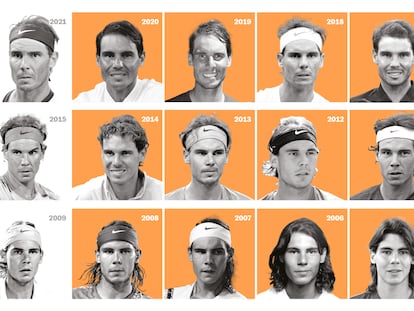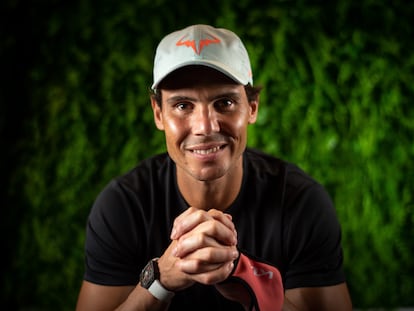Rafa Nadal: ‘You can’t accept being unable to train because you wake up with a limp every day’
Shortly after winning his 14th French Open in Paris, the tennis champion talked about his chronic foot pain and how he is planning to deal with it
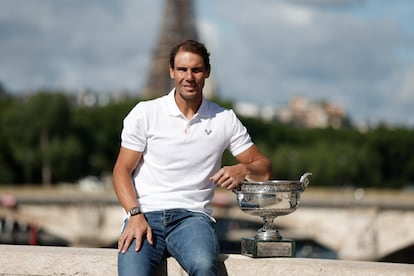
Rafael Nadal, 36, granted an interview to EL PAÍS and other Spanish media organizations inside a luxurious, Versailles-like room in a Paris hotel, the day after winning his 14th Roland Garros and 22nd Grand Slam men’s singles title. He sat in an armchair that he had trouble getting up from once the conversation ended. The Spanish tennis star had to use his arms to push himself up, and he walked with obvious difficulty.
The wear and tear of the previous day’s final was evident on a body that has withstood endless adversity. His has been the most closely watched foot on the planet in recent weeks. On this occasion, pain prevailed over tennis during the talk. The athlete spoke, but so did the patient. Nadal needs a solution for his chronic foot pain; since the beginning of his career he has suffered from Müller-Weiss syndrome, a degenerative foot disease with no solution for an elite athlete.
Question. How are you feeling?
Answer. Physically, the truth is that I am very well. In this tournament I have played matches of more than four hours, yet the next morning I have woken up well on a physical level. Surprisingly, at this point and at my age, I don’t have too many sore muscles. But this last one has not been a normal night, because my foot was hurting. It happens when it wakes up [when the anesthesia wears off] and after two and a half weeks taking loads of anti-inflammation medication and painkillers practically every six hours, because there was no other option. I’ve stopped because I can’t go on like this.
Q. How is it possible to play with a numb foot?
A. They blocked the sensory nerves. If the motor nerves are numbed, you can’t move your foot. They did that to me after an operation to avoid pain and you can’t move it, it’s impossible. But it’s not an exact science: in the end there are days when the numbness is a little lower. For example, at the final my toes also went numb, and the feeling was worse. But at least with the ankle you’re in control of the foot. The thing is that you don’t have any sensitivity down there and there is a little more risk when it comes to twisting your ankle. I don’t care if I don’t have sensitivity, because I went from limping to playing without pain. Unfortunately, this cannot be prolonged in time.
Q. Are you optimistic?
A. Let’s see what happens. The objective is clear, to carry out pulsed radiofrequency treatment in the nerve to try to achieve the feeling I have when I play with a numb foot, and making that permanent. If this treatment works and that feeling of pain is permanently removed, it may not solve the problem, but I could continue playing and that is the goal right now.
Q. At the beginning of the year you admitted that you considered giving up tennis, after half a year without playing due to the injury. Have you been tempted to withdraw again? Is all this worth it?
A. It’s always worth it, but what doesn’t make sense is if you do not feel competitive. If you can’t train, then how are you going to compete afterwards? And in recent months it has not been possible... We must trust in this possible solution [the new treatment]. I am quite realistic, I am not very dramatic nor very impulsive, and I make decisions according to what can and cannot be done, and things cannot continue the way they have these past few months. So let’s try it. If that works, I will be the first person to want to keep going, and also the people around me, because we all have a good time doing what we do. If this doesn’t work and we need to think about surgery, which doesn’t guarantee 100% recovery either... It will be a completely personal decision and I will have to decide whether it’s worth it or not.
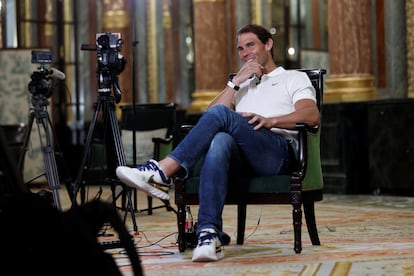
Q. At this point, what weighs more heavily, physical pain or emotional pain?
A. I don’t have any psychological pain. If I don’t have physical pain, I don’t have any psychological pain.
Q. But now you have this physical pain…
A. Yes, but I already knew I would have it. The issue is not the pain today; two weeks ago it was already very clear that when the tournament ended I was going to be in bad shape, and I accepted that, it is very easy to accept. The problem is the day-to-day. What you can’t accept is being unable to train regularly because you wake up with a limp every day. That in itself becomes difficult to assimilate; the rest is more complex.
Q. How do you imagine tomorrow?
A. I imagine it the same way I’ve experienced it many times in my career, when I’ve had to be out of competition for months due to injuries. I have always been happy outside of tennis. It is not something that makes me lose sleep or cause me any fear. I have and have always had many things that make me happy beyond tennis. As for the foot, I think they will be able to take away the pain in a pretty definitive way. The thing is, to eliminate it I have to undergo an operation that consists of fixing my foot, and if I do that, I won’t be able to continue playing.
Q. But, for example, could you get on your catamaran tomorrow without feeling the pain?
A. Not without pain, no. Last year I finished Roland Garros and I was limping for two and a half weeks. When I walked out of the match with Novak [Djokovic, against whom he lost in the semi-finals], I couldn’t even go down the stairs for two and a half weeks. When I stop playing for a while, I limp. The first few weeks are bad, but if I stop playing tennis for a month and a half, my daily life is no longer a problem. In the end there comes a time when it stops hurting, it bothers me, but it’s not a pain like the one I feel when I’m training.
Q. At least you will always have Parcheesi, one of your great hobbies. In some way, does it serve as therapy?
A. It depends on the day. There are days when it is a counterproductive therapy, because I have to put up with Marc [López, who joined the technical team this season], who has no frigging idea how to play[laughs]. But hey, we laugh. There’s a good thing about Parcheesi, and it is that an hour and a half or two go by without your noticing it. In addition, it is also a way to let go of the little machines [he says pointing to the celllphones recording the interview]. For me it is something positive.
Q. A year ago, Djokovic seemed to have the upper hand; now you are the boss. What will happen from here on?
A. Anything can happen, right? If what seemed likely a year ago is not so now, what seems likely now may not be so in a year... Novak is the one in a clearer situation, because of his level and the fact that he does not suffer from physical problems; Roger [Federer] is who he is, so you always have to expect something special from him, although we all know how difficult it is to come back and even more so at age 40... So we’ll see what happens. I don’t think about it much. I didn’t worry when we were tied or I was trailing, so I’m not going to worry now that I’m on top. The only thing that worries me is being able to continue having the opportunity to compete.
Q. What is this latest victory worth, all things considered?
A. I think that from the point of view of tennis it has considerable value, because some very good people have been defeated [including Félix Auger-Aliassime, ranked 9th in the world, Djokovic, ranked 1st and Zverev, ranked 3rd]. And on a mental level too, because in the end, I always value personal satisfaction more than anything else. After going through Indian Wells with a broken rib, and after Rome, when after just over one set I was already limping... I knew I was going to be able to play the matches, because you can play with a numb foot, but the difficult thing was having the ability to put all this aside and focus on the game at the level that I did. That means that mentally I was fully prepared to take on the challenge. What remains is that I have won a Roland Garros, perhaps one of the most difficult ones of my career and one of the most important. That’s what will stay with me.
Q. It’s the first time you’ve managed to win in Australia and Paris in the same year. Would it be crazy to think about the Grand Slam, about the possibility of also winning Wimbledon and the US Open?
A. Yes, it’s crazy. And more so in my current condition. Even in a perfect condition it would seem crazy to me because it is something that no male player has done since Rod Laver [the Australian did it in 1969, and Steffi Graf was the last tennis player to do so in 1988]. The one who came closest was Novak last year. I think it’s crazy to think about it. I won’t even consider it. More than winning, I would be happy to be able to play all four, taking into account how my foot is.
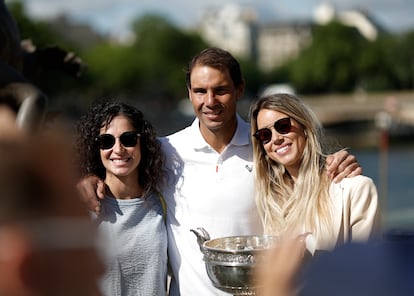
Q. You hoisted your first Roland Garros trophy 17 years ago, in 2005. Since then, how has tennis changed?
A. Tennis has changed, like everything in life... It is played faster now and we have to adapt. Before, a more classic tennis was played on clay, more like Casper [Ruud], and today there are fewer players with this style. I myself don’t play in this style anymore, most of the time. Things evolve, we all evolve and I myself have been changing, adapting my racket to have more power, for example.
Q. At the moment and despite all the setbacks, you are the player with the best overall record this season, winning four tournaments, including both Grand Slams that you played. To what extent does this provide you with an extra appetite for victory?
A. Feeling competitive gives you an energy boost, that’s a fact. Things would be different if I didn’t feel competitive considering my condition, but I feel competitive and we are going to look for solutions.
Tu suscripción se está usando en otro dispositivo
¿Quieres añadir otro usuario a tu suscripción?
Si continúas leyendo en este dispositivo, no se podrá leer en el otro.
FlechaTu suscripción se está usando en otro dispositivo y solo puedes acceder a EL PAÍS desde un dispositivo a la vez.
Si quieres compartir tu cuenta, cambia tu suscripción a la modalidad Premium, así podrás añadir otro usuario. Cada uno accederá con su propia cuenta de email, lo que os permitirá personalizar vuestra experiencia en EL PAÍS.
¿Tienes una suscripción de empresa? Accede aquí para contratar más cuentas.
En el caso de no saber quién está usando tu cuenta, te recomendamos cambiar tu contraseña aquí.
Si decides continuar compartiendo tu cuenta, este mensaje se mostrará en tu dispositivo y en el de la otra persona que está usando tu cuenta de forma indefinida, afectando a tu experiencia de lectura. Puedes consultar aquí los términos y condiciones de la suscripción digital.
More information
Archived In
Últimas noticias
Susan Boyle prepares a comeback just as Timothée Chalamet sings her praises
Trump suspends green card visa lottery after shooting at Brown University
When things get out of hand at the lab: Hundreds of accidents expose the ‘catastrophic’ risk of dangerous pathogen leaks
Venezuelan migrants contribute billions of dollars to Latin America, but continue to work in the informal sector
Most viewed
- Christian Louboutin: ‘Young people don’t want to be like their parents. And if their parents wear sneakers, they’re going to look for something else’
- Cartels in Mexico take a leap forward with narco-drones: ‘It is criminal groups that are leading the innovation race’
- Liset Menéndez de la Prida, neuroscientist: ‘It’s not normal to constantly seek pleasure; it’s important to be bored, to be calm’
- ‘El Limones’ and the growing union disguise of Mexican organized crime
- The low-cost creative revolution: How technology is making art accessible to everyone

